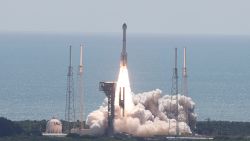NASA’s next mission to Mars will be its most advanced yet. But if scientists discover there was once life – or there is life –on the Red Planet, will the public be able to handle such an extraterrestrial concept?
NASA chief scientist Jim Green doesn’t think so.
“It will be revolutionary,” Green told the Telegraph. “It will start a whole new line of thinking. I don’t think we’re prepared for the results. We’re not.”

The agency’s Mars 2020 rover, set to launch next summer, will be the first to collect samples of Martian material to send back to Earth. But if scientists discover biosignatures of life in Mars’ crust, the findings could majorly rock astrobiology, said Green, the director of the Planetary Science Division at NASA.
“What happens next is a whole new set of scientific questions,” he said. “Is that life like us? How are we related?”
The Mars 2020 rover, along with the European Space Agency’s ExoMars rover, will drill into the Martian crust. The surface of the Red Planet is believed to be radioactive, soif there is life on Mars, it likely livesbelow ground.
“We’ve never drilled that deep,” he told the Telegraph. “When environments get extreme, life moves into the rocks.”
The principle’s been proven on our home planet: After drilling miles into the Earth, researchers found more life in the Earth’s crust than on its surface, he said.
“The bottom line is, where there is water there is life.”
And if the agencies’ new rovers find proof that water once flowed on Mars, he said, the confirmation could come weeks or months of landing – so buckle up, space lovers. The realm of possibility might get much wider very soon.
The next mission to Mars
NASA’s Mars 2020 rover will launch in July 2020 and land at the Red Planet’s Jezero Crater in February 2021 (Mars is 140 million miles from Earth, after all). It’s equipped with two high-definition cameras and a detachable helicopter to take aerial images of the planet’s cliffs, caves and craters.
The mission’s main aim is to search for signs of life. The rover will look for past habitable environments, find biosignatures in rock and will test those samples back on Earth.
But if scientists fail to find evidence of life, that won’t end the hope for human exploration. Mars 2020 will test oxygen production on the planet and monitor Martian weather to evaluate how potential human colonies could fare on Mars.
Clarification: The headline of this piece has been changed to more accurately reflect NASA’s chief scientist’s comments regarding efforts to finding life on Mars.




















